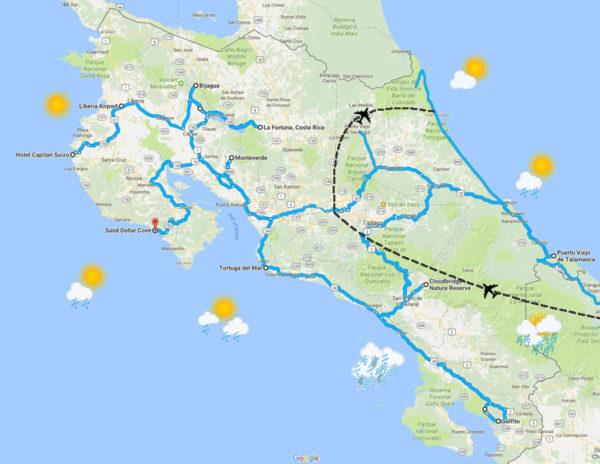Costa Rica Rainy Season Travel
A lot of people ask us “will there be any sun if I go to the beach in rainy season?” but a better question might be “is it possible to go to the beach in rainy season?”
We spent this August and an unexpected bit of September traveling all over Costa Rica gathering updates for a new edition of the Waterproof Travel Map of Costa Rica and last September and October working our way down the Caribbean coast.

We counted 60 out of 63 days with at least 4 hours of full sun plus no rain at all on 45 of those days during 9 weeks of travel in the very heart of the rainy season.
Even in the rainy season you’re likely to need the sunscreen way more than your umbrella unless you’re using the umbrella for shade.
Just because there was no rain on almost 3/4 of the days doesn’t mean it was dry. It rained almost every night and when it did rain during the day it fell in astonishing downpours.
It was also much cooler with temperatures in the low to mid 80s (around 28 °C) instead of the sweltering 90s (34 °C) in the dry season months of January through April.
It sounds perfect. Sunny days and cooling downpours with fantastic lightning storms while you sip a beer at dinner or doze under your mosquito net.
Weather Related Detours & Delays
We spent a few days at the fantastic boat in off the grid ecolodge at Playa Nicuesa in the heart of Piedras Blancas National Park on the Golfo Dulce of the Osa. We had beautiful sunny mornings for a guided wildlife hike, a waterfall climb and on the morning of the last day and amazing dolphin/whale/snorkeling tour of the Gulf.
When we loaded into the boat after lunch to head back to Golfito the wind was picking up, choppy waves forming, and immense black clouds were gathering. By the time we tossed our packs in the back of the Land Rover and waved to the intrepid souls who were loading into the boat to take our places at Nicuesa it was raining – hard.
We drove through sheets and buckets of rain for three hours to reach our next destination at Río Chirripo Retreat on the slopes of the highest peak in Costa Rica. When we scanned the news at breakfast the next morning under crystal clear blue skies we saw the image below of the road we had just driven.
![]() A huge chunk of the PanAmerican Highway had dropped off the hillside sometime in the night. If we had tried to leave Nicuesa a day later or any time in the two weeks it took to reopen the road we would have faced a five hour detour heading first east then north into the mountains and San Vito then turning back northwest on a horrendous gravel and potholed asphalt track at 30 kph.
A huge chunk of the PanAmerican Highway had dropped off the hillside sometime in the night. If we had tried to leave Nicuesa a day later or any time in the two weeks it took to reopen the road we would have faced a five hour detour heading first east then north into the mountains and San Vito then turning back northwest on a horrendous gravel and potholed asphalt track at 30 kph.
And, we would have been sorta lucky. There are times when there is no detour. One year there was no way to get from San José to either coast by road for three days.
We’ve not always been so lucky and have had to adjust our travel plans several times due to road closures. Since we’re usually traveling for a month or two at a time it’s not a big deal but losing a day or two out of a week long trip can be a real bummer.
Landslides usually get progressively more common as the rainy season progresses. November is often the worst even though more rain typically falls in the mountains in September and October. With even a little rain roads simply wash down the hillside (derrumbe – collapse) or the hillside washes onto the road blocking it (deslizamiento – landslide) because the ground is totally saturated.
If you can get where you’re going the rainy season can be a great time to visit. Planning to avoid the most notorious roads can help.
- Pan American Highway (Hwy 2) south of San Jose to San Isidro de el General
- Caldera Highway (Hwy 27) from Escazu to Caldera on the Pacific
- Guapiles Highway (Hwy 32) from San Jose to the Caribbean
- Arenal Lake Road (Route 142) from La Fortuna to Tilaran which is the main route from the volcano to the Guanacaste beaches and Monteverde cloud forest.
Flights are Also Impacted
The domestic airlines offer many fewer afternoon flights this time of year because the risk of weather related cancellation is high. If you have a choice go early.
Weather also has big impacts on international flights this time of year. A few years ago in July we were on a flight from Miami to San José that had to abort landing three times because it was raining so hard the pilot couldn’t see the runway. We ran so low on fuel that we had to land in Liberia and take on some more jetA before taking of and finally touching down in San José on the fourth attempt. They couldn’t let us off in Liberia because customs wasn’t available and there were some nervous fliers who needed medical attention when they disembarked.
On this most recent trip we ended up spending almost an extra week in Costa Rica because our return flight to Denver was scheduled to stopover in Houston which was completely shut down byu Hurricane Harvey. Southwest airlines started flying though Atlanta instead and got us on a flight.
I’m not sure if weather related delays and cancellations are more common during the rainy season or when it’s bone dry in Costa Rica from January to April but Chicago, Baltimore, Denver, or even Houston may be shut down because of ice and snow. It is clear that domestic flights are more likely to be cancelled in June through November.
So break out your sunscreen, cross your fingers and book a trip in the low season. I guarantee it will be a great adventure.
